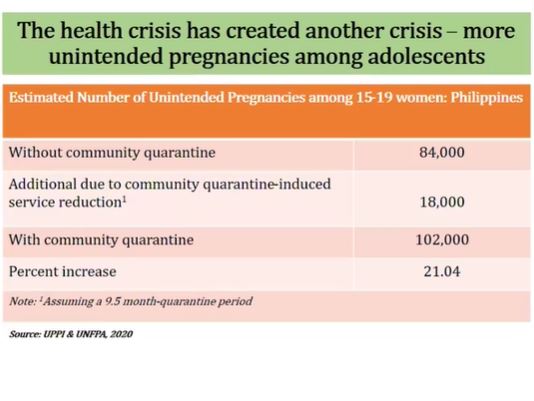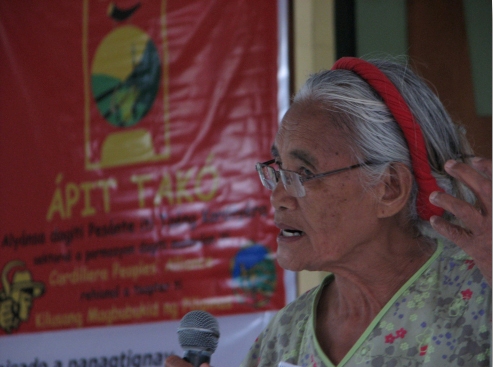Teen pregnancies and child marriages have been pressing concerns in the Philippines but the pandemic and the lockdown intended to curb it aggravated the problems, officials and rights advocates say.
“Even before COVID-19, from Cagayan Valley to Lanao del Sur, we saw how child marriage increases in areas where there is deep poverty, plenty of disasters and other forms of crisis,” said Lot Felizco, country director of development and humanitarian organization Oxfam Philippines.
The pandemic is “the reason for the increase of gender-based violence, especially in evacuation camps and temporary shelters,” she said in at the #GirlDefenders Speak Out to End Child Marriage Zoomlidarity Rally on March 5.
She did not elaborate but recurring natural calamities and armed conflicts in the country have forced families to evacuate from their communities, with women and girls bearing the brunt of these difficult conditions.
Felizco added that “social and gender norms fuel the practice of child marriage.”
The Philippines is the 12th country worldwide to have the most number of child marriages with around 726,000, as listed by the UNFPA in their 2020 policy brief. It also claimed that one out of six teenage girls are already married in the country.
In another forum a week earlier, Commission on Population and Development (PopCom) Executive Director Jose Perez III said that the problem of teenage pregnancy is “likely to continue and even exceed the current record” because of the absence of health and family planning services while under quarantine.
“Unintended pregnancies are of great concern since these are associated with a range of adverse consequences not only for the mother but for her child as well, especially when the mother is still a child herself,” he said during a webinar on Feb. 26 called “Amplified: Young Voices for Adolescent Health.”
In 2020 alone, more than 102,000 teens aged 15 and above gave birth, including an additional 18,000 due to almost 10 months of community quarantine amid the pandemic. This compares to the estimate without community quarantine of 84,000, according to a study by the University of the Philippines Population Institute and the United Nations Population Fund (UNFPA).

Rom Dongeto, director of the Philippine Legislators’ Committee on Population and Development (PLCPD) said in last month’s webinar that the cases of unintended pregnancies can be “attributed to early sexual initiation and unprotected sex yet many are definitely victims of statutory rape and child sexual abuse.”
Worsening over time
The issue of teen pregnancies has been a pressing problem for years, prompting the National Economic Development Authority (NEDA) to declare it as a national social emergency in 2019.
PopCom’s Perez said that in 2002, most of those who engaged in premarital sex were males aged 15 to 19. “However, in 2013, we saw the number of women rise with the number of men engaging in premarital sex before 18.”
But 2019 showed a drastic change in terms of teenage pregnancies. Births among 10-14 year-old mothers increased to seven births a day in 2019, compared to three births/day in 2011, said Perez, citing numbers from the Philippines Statistics Authority (PSA).
The Social Weather Stations (SWS) reported that 59% or almost 6 out of 10 Filipinos, polled in November 2020, believe that teenage pregnancy is the most important problem of women today.
Apart from teen mothers, fathers aged below 20 have also steadily increased since 2010.
Mai Quiray of PopCom said one of their programs on teen pregnancy also focuses on communicating with teen fathers about their responsibility and their adolescent reproductive and sexual health. Especially with the rise of these cases, they should not be left out.
Women usually take one year to get pregnant and give birth, but men can impregnate more in a year, she said.
“It is important for teen fathers to also get this message because their roles grow bigger in terms of youth pregnancies,” said Perez.
Better communication between teenagers and parents may decrease the likelihood of risky sexual activity, according to Perez, but PopCom data shows only 10% of Filipino parents discuss sexuality with their adolescent children.
Adolescent mothers
The Popcom director said early marriage compromises a minor’s opportunities.” More and more minors who have given birth had repeat pregnancies,” he said. “And based on my observation, if you have given birth to your second child as a minor, most likely, you will not be able to finish your studies and return to school.
Apart from halting education, teen mothers face more risks.
Mothers aged 10 to 19 face higher risks of diseases such as eclampsia, puerperal endometritis and systemic infections than women aged 20 to 24 years, according to the World Health Organization, while babies of adolescent mothers also face higher risks of low birth weight, preterm delivery and severe neonatal conditions.
Adolescent and young adult women also experience physical, sexual or emotional violence from their husbands or partners during pregnancy.
Policies to prevent rise of adolescent pregnancy, child marriages
Bills have been filed in both Houses in Congress to address the rise in adolescent pregnancies.
Sen. Risa Hontiveros, who chairs the Committee on Women, filed Senate Bill (SB) 1334 or the Prevention of Adolescent Pregnancy Act of 2020.
The bill, which has been pending on 2nd reading since Feb. 12, 2020, aims to create a national program specifically on the prevention of adolescent pregnancy, and proposes comprehensive sexual education to be integrated in all school levels.
For the House of Representatives, Malou Acosta-Alba who sits as the Chair on Committee on Women and Gender Equality, was among the filed House Bill (HB) 6528 or the Prevention of Adolescent Pregnancy Act of 2020.
Mariquit Melgar, a staff member of Acosta-Alba, said “While we have several laws on reproductive health and healthcare, such as the Universal healthcare Act, there is no law that specifically addresses problems surrounding adolescent pregnancy,” highlighting the bill’s importance.
In crafting the bills concerning teen pregnancy, Rena Dona of the UNFPA said at least 1200 members of the youth were surveyed to see their top concerns in relation to adolescent pregnancies to “ensure young people’s concerns are addressed.”
The top concern was the lack of correct information regarding sexual and reproductive health, which 82% of the respondents listed as the first priority, followed by the lack of guidance from parents and guardians which accounted for 75 percent and lastly, the lack of access to adolescent sexual and reproductive health services, such as contraceptive commodities, which amount to 65 percent.
“To address these concerns, young people expressed that the government needs to mobilize an intensive and targeted age-appropriate gender-responsive culturally appropriate advocacy campaign and awareness raising, for both online and offline platforms,” said Dona.
In an effort to ban child marriages, Dep. speaker Bernadette Herrera-Dy, also the first legislator who sought to ban child marriages in the 17th congress, filed 1486 or An Act Protecting Children by Prohibiting and Declaring Child Marriage as Illegal.
The bill aims to authorize the DSWD to formulate a comprehensive program and services to ensure support of child marriage prohibition. It was recently submitted on March 2, 2021, to the Committee on Justice since it was filed on July 4, 2019.
In the Senate, Hontiveros filed on Feb. 26, 2020, a similar bill with SB No. 1373 which proibits and declares child marriage as illegal.
PopCom has also said that the fate of thousands of these adolescent girls hangs in the balance with the stalling of the bills.
Teen pregnancies are a problem to all, “especially the Filipino youth,” said PLCPD’s Dongeto.
These bills should be enacted into law “because child marriages continue….They are not isolated cases,” he said.




